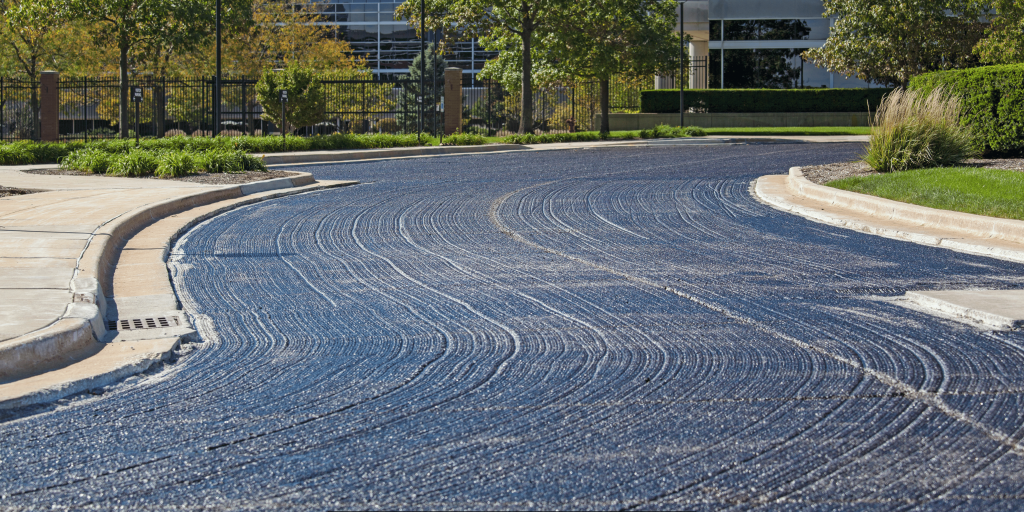Asphalt paving is the standard procedure of providing a paved surface to driveways, parking lots, roads, and other areas. What happens after the hot asphalt mixture has been spread and compacted by a roller? How long can it take before one can walk on it or drive over it? Walking on the asphalt too soon after it is newly paved can leave marks, indents, or other harm to the new layer.
Setting and Curing Time of Asphalt
The asphalt setting and curing timeline can vary based on a few key factors:

• Asphalt Mix – The type of materials used in the asphalt mix and the proportion of them also affect the drying/curing time. Examples include the addition of more oil, which may lead to longer drying times. Therefore, a custom mix may be faster or slower than others.
• Temperature – Warmer temperatures outdoors are suitable for the set-up of asphalt compared to cold temperatures that delay the drying of the asphalt.
• Thickness – Thicker asphalt sections contain more heat, which helps the mat retain more heat and gain strength more quickly after paving.
• Base Layer – An aggregate or concrete base below the asphalt surface retains heat longer, thus providing the concrete surface with a quick drying time.
• Compaction – Proper compaction during installation minimizes air voids and enhances the curing process of the asphalt.
General Timeline
While the exact timeline varies, here is a general framework for how long after paving asphalt is ready for foot traffic or vehicles:
Pedestrian Foot Traffic
– 2 to 4 hours – It is usually enough time for most pavement to have enough set up so that very light foot traffic can be allowed in most cases. No pointed heels or flat soles should be worn.
– 6 to 12 hours – Asphalt is hard enough to allow pedestrians to walk over it without concern for leaving impressions on the surface.
Vehicle Traffic
– 24 hours – After a full day of curing, it is usually possible for lightweight vehicles, such as single-axle trucks or cars, to be driven on the surface of the asphalt. Do not select vehicles with trailers or with double rear wheels.
– 3 to 7 days – At average temperatures, asphalt takes 3 to 7 days to gain more than 90% of its strength to support traffic from heavy vehicles. Cold temperatures may take more time for heavy traffic, mainly during the evening rush hour.
The best thing to do is to keep vehicles off the pavement until you are sure the asphalt has cured properly. This is because when the wheels make contact with the partially cured asphalt, they may leave some sort of mark, a track, or an imprint that remains permanently on the surface.
Determining If Asphalt Is Ready
The most effective check is to perform a touch test to determine if the surface is still soft or extremely hot.

Here are some guides:
– Can dent with a knuckle or fingernail – No foot or vehicle traffic allowed yet.
– Still warm to the touch – Do not operate motor vehicles on the pavement until it has cooled down. Pedestrian traffic risks marks.
– Near ambient temperature – Asphalt has usually gained sufficient strength for light pedestrian and vehicular traffic.
Additionally, the mat surface should be visually examined and checked for impressions. If you can press an object into the surface and create an impression which is a quarter of an inch or more profound, then it probably needs more time before allowing vehicles.
Notes of Caution During First Time Use of New Asphalt
Once deemed ready for foot or vehicle traffic, take care when first walking or driving on fresh asphalt:
• Do not make frequent acceleration/deceleration because torque to new asphalt requires smooth acceleration.
• Lower car speeds to minimize chances of spinning tires.
• Start by driving closer to the edge of the paved area first.
• Do not drive with water, oil or other liquids which can make the asphalt surface soft before it has been appropriately cured.
• Avoid walking on the pavement as much as possible in the initial 5 to 7 days, as oils and scuffing shoes may cause early signs of wear or stains.
The first week is the most important because it is when a new asphalt acquires hardness but is still susceptible to wear and tear until it has fully cured. Ensure that you wait and remain as patient as possible for the result for your newly surfaced asphalt pavement to be optimal.
Conclusion
When answering the question “how many hours after paving asphalt can you walk on it?”–enough curing time should be observed. The exact time required to cure varies with the climate, the thickness, and the ingredients used in preparation. However, it is acceptable to allow 2 to 4 hours for light pedestrian traffic, at least 24 hours for light vehicle traffic, and 3 to 7 days for heavy traffic. It is all about patience for the best asphalt and maximum durability and appearance.

